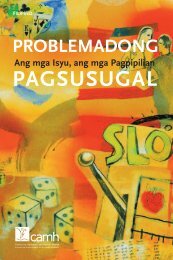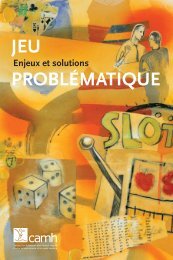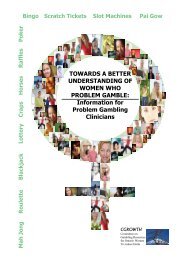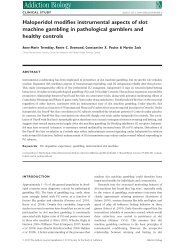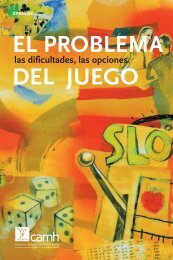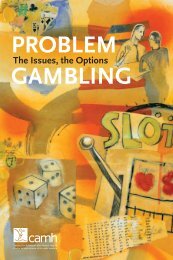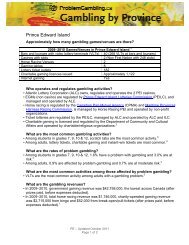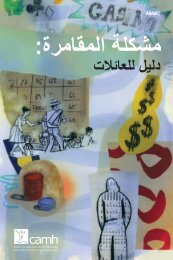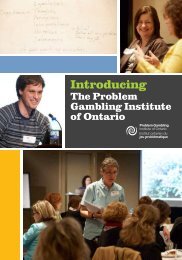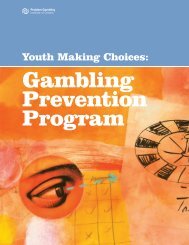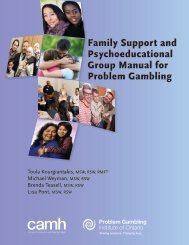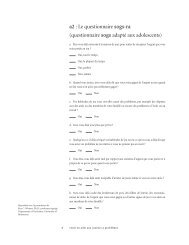Probability, Random Events, and the Mathematics of Gambling
Probability, Random Events, and the Mathematics of Gambling
Probability, Random Events, and the Mathematics of Gambling
You also want an ePaper? Increase the reach of your titles
YUMPU automatically turns print PDFs into web optimized ePapers that Google loves.
winning symbols on <strong>the</strong> payline, we may overestimate <strong>the</strong> chances <strong>of</strong> getting three <strong>of</strong> <strong>the</strong> big<br />
win symbols. This overestimation <strong>of</strong> <strong>the</strong> odds is also likely enhanced by seeing <strong>the</strong> big win<br />
symbols spin by on each spin, <strong>the</strong> occurrence <strong>of</strong> big win symbols above or below <strong>the</strong> payline,<br />
<strong>the</strong> distortion <strong>of</strong> <strong>the</strong> apparent odds caused by virtual reel mapping, <strong>and</strong> <strong>the</strong> larger number <strong>of</strong><br />
big win symbols on <strong>the</strong> first two reels (see Turner & Horbay, 2004).<br />
Law <strong>of</strong> Averages <strong>and</strong> <strong>the</strong> Law <strong>of</strong> Large Numbers<br />
Part <strong>of</strong> <strong>the</strong> explanation for <strong>the</strong> persistent belief among those who gamble that <strong>the</strong>re are<br />
patterns in chance, may stem from a misunderst<strong>and</strong>ing <strong>of</strong> two related “laws” <strong>of</strong> statistics: <strong>the</strong><br />
law <strong>of</strong> averages <strong>and</strong> <strong>the</strong> law <strong>of</strong> large numbers. The first is an informal folk <strong>the</strong>ory <strong>of</strong> statistics;<br />
<strong>the</strong> second is a statistical law. These laws can be summarized as follows:<br />
Law <strong>of</strong> Averages: Things average out over time.<br />
Law <strong>of</strong> Large Numbers: As <strong>the</strong> sample size increases <strong>the</strong> average <strong>of</strong> <strong>the</strong> actual outcomes<br />
will more closely approximate <strong>the</strong> ma<strong>the</strong>matical probability.<br />
The law <strong>of</strong> large numbers is a useful way to underst<strong>and</strong> betting outcomes. A coin on average<br />
will come up heads 50% <strong>of</strong> <strong>the</strong> time. It could none<strong>the</strong>less come up heads 100% <strong>of</strong> <strong>the</strong> time or<br />
0% <strong>of</strong> <strong>the</strong> time. In a short trial, heads may easily come up on every flip. The larger <strong>the</strong><br />
number <strong>of</strong> flips, however, <strong>the</strong> closer <strong>the</strong> percentage will be to 50%.<br />
The law <strong>of</strong> averages is an informal approximation <strong>of</strong> <strong>the</strong> law <strong>of</strong> large numbers. The problem<br />
with <strong>the</strong> law <strong>of</strong> averages, as it is <strong>of</strong>ten understood, is that people assume that if something has<br />
not happened it is due to happen. For example, a person who gambles might expect that if<br />
heads have come up 10 times in a row, <strong>the</strong> next flip is more likely to be tails because <strong>the</strong> flips<br />
have to average out to 50%. Many people believe that deviations from chance are corrected<br />
by subsequent events <strong>and</strong> refer to <strong>the</strong> law <strong>of</strong> averages in support <strong>of</strong> <strong>the</strong>ir belief. Turner,<br />
Wiebe, Falkowski-Ham, Kelly <strong>and</strong> Skinner (2005) found that 36% <strong>of</strong> <strong>the</strong> general population<br />
believes that after 5 heads in a row <strong>the</strong> next flip is more likely to be tails. The law <strong>of</strong> large<br />
numbers, on <strong>the</strong> o<strong>the</strong>r h<strong>and</strong>, asserts only that <strong>the</strong> average converges towards <strong>the</strong> true mean as<br />
more observations are added. The average is not somehow corrected to ensure it reflects <strong>the</strong><br />
expected average. The key difference is in <strong>the</strong> expectation. After a streak <strong>of</strong> 10 heads in a<br />
row, <strong>the</strong> law <strong>of</strong> averages would predict that more tails should come up so that <strong>the</strong> average is<br />
balanced out. The law <strong>of</strong> large numbers only predicts that after a sufficiently large number <strong>of</strong><br />
trials, <strong>the</strong> streak <strong>of</strong> 10 heads in a row will be statistically irrelevant <strong>and</strong> <strong>the</strong> average will be<br />
close to <strong>the</strong> ma<strong>the</strong>matical probability.<br />
Some people accept <strong>the</strong> idea that <strong>the</strong> measured average will reflect <strong>the</strong> probability percentage<br />
in <strong>the</strong> long run, but still expect that if a trial <strong>of</strong> coin tosses began with a streak <strong>of</strong> heads, after<br />
9




